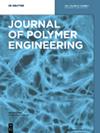Synthesis and properties of AM/AMPS/MMA and cationic monomer copolymer flooding agent
IF 1.7
4区 工程技术
Q4 POLYMER SCIENCE
引用次数: 0
Abstract
A novel hydrophobic association copolymer (PAMA) was synthesized by incorporating acrylamide (AM), 2-acrylamide-2-methylpropanesulfonic acid (AMPS), cationic monomer (MEDDA), and methyl methacrylate (MMA). The properties of MMA copolymers with varying contents were analyzed using infrared spectroscopy, nuclear magnetic resonance spectroscopy, and scanning electron microscopy. Optimal overall performance of the solution was achieved when the MMA content reached 1.4 % w/w. Compared to pure PAAM (without MMA), the PAMA-1.4 % polymer exhibited superior viscoelasticity, temperature resistance, and shear resistance. This enhancement in PAMA performance can be attributed to the significant inhibition of intermolecular water film formation within the polymer matrix by MMA, effectively improving and regulating solution solubility while strengthening molecular chain interactions and enhancing the structural network strength of PAMA polymers. Additionally, the inclusion of MMA transformed rock surfaces from non-wetting to wetting conditions, thereby greatly improving oil displacement efficiency. In displacement experiments, PAMA-1.4 % performed better in terms of enhanced oil recovery, the recovery rate of 0.1 % w/w PAMA-2.4 % solution is only 7.78 %, while the recovery rate of 0.1 % w/w PAMA-1.4 % solution is 13.06 %.AM/AMPS/MMA 与阳离子单体共聚物淹没剂的合成与特性
通过加入丙烯酰胺(AM)、2-丙烯酰胺-2-甲基丙磺酸(AMPS)、阳离子单体(MEDDA)和甲基丙烯酸甲酯(MMA),合成了一种新型疏水缔合共聚物(PAMA)。使用红外光谱、核磁共振光谱和扫描电子显微镜分析了不同含量的甲基丙烯酸甲酯共聚物的特性。当 MMA 含量达到 1.4 % w/w 时,溶液的整体性能达到最佳。与纯 PAAM(不含 MMA)相比,PAMA-1.4% 聚合物表现出更优越的粘弹性、耐温性和抗剪切性。PAMA 性能的提高可归因于 MMA 显著抑制了聚合物基质中分子间水膜的形成,从而有效改善和调节了溶液溶解度,同时加强了分子链的相互作用,提高了 PAMA 聚合物的结构网络强度。此外,MMA 的加入还使岩石表面从非润湿状态转变为润湿状态,从而大大提高了石油的置换效率。在置换实验中,PAMA-1.4 % 在提高石油采收率方面表现更好,0.1 % w/w PAMA-2.4 % 溶液的采收率仅为 7.78 %,而 0.1 % w/w PAMA-1.4 % 溶液的采收率为 13.06 %。
本文章由计算机程序翻译,如有差异,请以英文原文为准。
求助全文
约1分钟内获得全文
求助全文
来源期刊

Journal of Polymer Engineering
工程技术-高分子科学
CiteScore
3.20
自引率
5.00%
发文量
95
审稿时长
2.5 months
期刊介绍:
Journal of Polymer Engineering publishes reviews, original basic and applied research contributions as well as recent technological developments in polymer engineering. Polymer engineering is a strongly interdisciplinary field and papers published by the journal may span areas such as polymer physics, polymer processing and engineering of polymer-based materials and their applications. The editors and the publisher are committed to high quality standards and rapid handling of the peer review and publication processes.
 求助内容:
求助内容: 应助结果提醒方式:
应助结果提醒方式:


